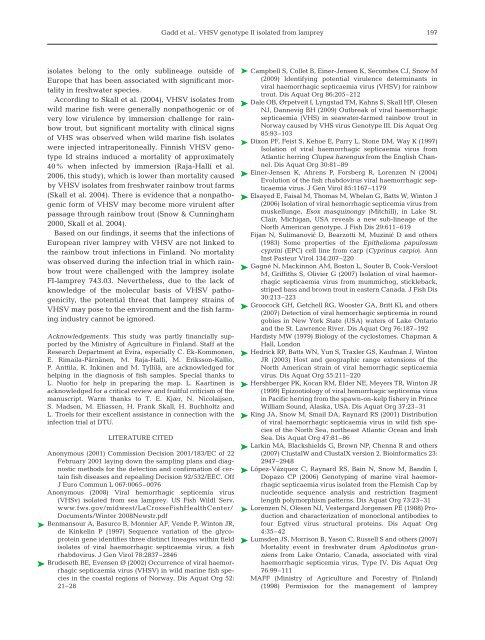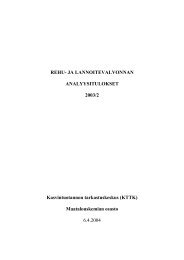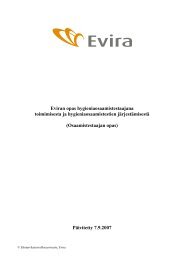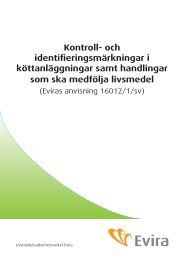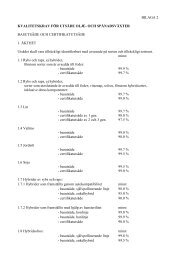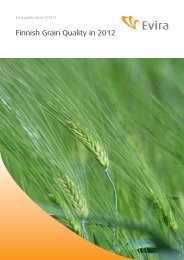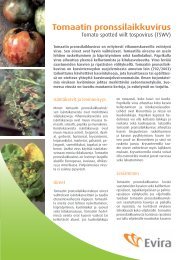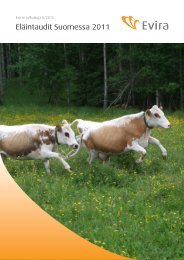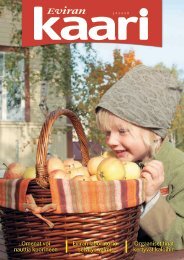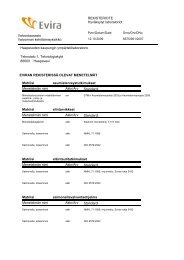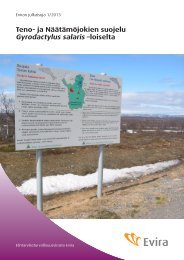Dis Aquat Org - Inter Research
Dis Aquat Org - Inter Research
Dis Aquat Org - Inter Research
Create successful ePaper yourself
Turn your PDF publications into a flip-book with our unique Google optimized e-Paper software.
isolates belong to the only sublineage outside of<br />
Europe that has been associated with significant mortality<br />
in freshwater species.<br />
According to Skall et al. (2004), VHSV isolates from<br />
wild marine fish were generally nonpathogenic or of<br />
very low virulence by immersion challenge for rainbow<br />
trout, but significant mortality with clinical signs<br />
of VHS was observed when wild marine fish isolates<br />
were injected intraperitoneally. Finnish VHSV genotype<br />
Id strains induced a mortality of approximately<br />
40% when infected by immersion (Raja-Halli et al.<br />
2006, this study), which is lower than mortality caused<br />
by VHSV isolates from freshwater rainbow trout farms<br />
(Skall et al. 2004). There is evidence that a nonpathogenic<br />
form of VHSV may become more virulent after<br />
passage through rainbow trout (Snow & Cunningham<br />
2000, Skall et al. 2004).<br />
Based on our findings, it seems that the infections of<br />
European river lamprey with VHSV are not linked to<br />
the rainbow trout infections in Finland. No mortality<br />
was observed during the infection trial in which rainbow<br />
trout were challenged with the lamprey isolate<br />
FI-lamprey 743.03. Nevertheless, due to the lack of<br />
knowledge of the molecular basis of VHSV pathogenicity,<br />
the potential threat that lamprey strains of<br />
VHSV may pose to the environment and the fish farming<br />
industry cannot be ignored.<br />
Acknowledgements. This study was partly financially supported<br />
by the Ministry of Agriculture in Finland. Staff at the<br />
<strong>Research</strong> Department at Evira, especially C. Ek-Kommonen,<br />
E. Rimaila-Pärnänen, M. Raja-Halli, M. Eriksson-Kallio,<br />
P. Anttila, K. Inkinen and M. Tyllilä, are acknowledged for<br />
helping in the diagnosis of fish samples. Special thanks to<br />
L. Nuotio for help in preparing the map. L. Kaartinen is<br />
acknowledged for a critical review and fruitful criticism of the<br />
manuscript. Warm thanks to T. E. Kjær, N. Nicolaijsen,<br />
S. Madsen, M. Eliassen, H. Frank Skall, H. Buchholtz and<br />
L. Troels for their excellent assistance in connection with the<br />
infection trial at DTU.<br />
LITERATURE CITED<br />
Anonymous (2001) Commission Decision 2001/183/EC of 22<br />
February 2001 laying down the sampling plans and diagnostic<br />
methods for the detection and confirmation of certain<br />
fish diseases and repealing Decision 92/532/EEC. Off<br />
J Euro Commun L 067:0065–0076<br />
Anonymous (2008) Viral hemorrhagic septicemia virus<br />
(VHSv) isolated from sea lamprey. US Fish Wildl Serv.<br />
www.fws.gov/midwest/LaCrosseFishHealthCenter/<br />
Documents/Winter 2008Newstr.pdf<br />
Benmansour A, Basurco B, Monnier AF, Vende P, Winton JR,<br />
de Kinkelin P (1997) Sequence variation of the glycoprotein<br />
gene identifies three distinct lineages within field<br />
isolates of viral haemorrhagic septicaemia virus, a fish<br />
rhabdovirus. J Gen Virol 78:2837–2846<br />
Brudeseth BE, Evensen Ø (2002) Occurrence of viral haemorrhagic<br />
septicaemia virus (VHSV) in wild marine fish species<br />
in the coastal regions of Norway. <strong>Dis</strong> <strong>Aquat</strong> <strong>Org</strong> 52:<br />
21–28<br />
Gadd et al.: VHSV genotype II isolated from lamprey<br />
197<br />
Campbell S, Collet B, Einer-Jensen K, Secombes CJ, Snow M<br />
(2009) Identifying potential virulence determinants in<br />
viral haemorrhagic septicaemia virus (VHSV) for rainbow<br />
trout. <strong>Dis</strong> <strong>Aquat</strong> <strong>Org</strong> 86:205–212<br />
Dale OB, Ørpetveit I, Lyngstad TM, Kahns S, Skall HF, Olesen<br />
NJ, Dannevig BH (2009) Outbreak of viral haemorrhagic<br />
septicaemia (VHS) in seawater-farmed rainbow trout in<br />
Norway caused by VHS virus Genotype III. <strong>Dis</strong> <strong>Aquat</strong> <strong>Org</strong><br />
85:93–103<br />
Dixon PF, Feist S, Kehoe E, Parry L, Stone DM, Way K (1997)<br />
Isolation of viral haemorrhagic septicaemia virus from<br />
Atlantic herring Clupea harengus from the English Channel.<br />
<strong>Dis</strong> <strong>Aquat</strong> <strong>Org</strong> 30:81–89<br />
Einer-Jensen K, Ahrens P, Forsberg R, Lorenzen N (2004)<br />
Evolution of the fish rhabdovirus viral haemorrhagic septicaemia<br />
virus. J Gen Virol 85:1167–1179<br />
Elsayed E, Faisal M, Thomas M, Whelan G, Batts W, Winton J<br />
(2006) Isolation of viral hemorrhagic septicemia virus from<br />
muskellunge, Esox masquinongy (Mitchill), in Lake St.<br />
Clair, Michigan, USA reveals a new sub-lineage of the<br />
North American genotype. J Fish <strong>Dis</strong> 29:611–619<br />
Fijan N, Sulimanović D, Bearzotti M, Muzinić D and others<br />
(1983) Some properties of the Epithelioma papulosum<br />
cyprini (EPC) cell line from carp (Cyprinus carpio). Ann<br />
Inst Pasteur Virol 134:207–220<br />
Gagné N, Mackinnon AM, Boston L, Souter B, Cook-Versloot<br />
M, Griffiths S, Olivier G (2007) Isolation of viral haemorrhagic<br />
septicaemia virus from mummichog, stickleback,<br />
striped bass and brown trout in eastern Canada. J Fish <strong>Dis</strong><br />
30:213–223<br />
Groocock GH, Getchell RG, Wooster GA, Britt KL and others<br />
(2007) Detection of viral hemorrhagic septicemia in round<br />
gobies in New York State (USA) waters of Lake Ontario<br />
and the St. Lawrence River. <strong>Dis</strong> <strong>Aquat</strong> <strong>Org</strong> 76:187–192<br />
Hardisty MW (1979) Biology of the cyclostomes. Chapman &<br />
Hall, London<br />
Hedrick RP, Batts WN, Yun S, Traxler GS, Kaufman J, Winton<br />
JR (2003) Host and geographic range extensions of the<br />
North American strain of viral hemorrhagic septicaemia<br />
virus. <strong>Dis</strong> <strong>Aquat</strong> <strong>Org</strong> 55:211–220<br />
Hershberger PK, Kocan RM, Elder NE, Meyers TR, Winton JR<br />
(1999) Epizootiology of viral hemorrhagic septicemia virus<br />
in Pacific herring from the spawn-on-kelp fishery in Prince<br />
William Sound, Alaska, USA. <strong>Dis</strong> <strong>Aquat</strong> <strong>Org</strong> 37:23–31<br />
King JA, Snow M, Smail DA, Raynard RS (2001) <strong>Dis</strong>tribution<br />
of viral haemorrhagic septicaemia virus in wild fish species<br />
of the North Sea, northeast Atlantic Ocean and Irish<br />
Sea. <strong>Dis</strong> <strong>Aquat</strong> <strong>Org</strong> 47:81–86<br />
Larkin MA, Blackshields G, Brown NP, Chenna R and others<br />
(2007) ClustalW and ClustalX version 2. Bioinformatics 23:<br />
2947–2948<br />
López-Vázquez C, Raynard RS, Bain N, Snow M, Bandín I,<br />
Dopazo CP (2006) Genotyping of marine viral haemorrhagic<br />
septicaemia virus isolated from the Flemish Cap by<br />
nucleotide sequence analysis and restriction fragment<br />
length polymorphism patterns. <strong>Dis</strong> <strong>Aquat</strong> <strong>Org</strong> 73:23–31<br />
Lorenzen N, Olesen NJ, Vestergard Jorgensen PE (1988) Production<br />
and characterization of monoclonal antibodies to<br />
four Egtved virus structural proteins. <strong>Dis</strong> <strong>Aquat</strong> <strong>Org</strong><br />
4:35–42<br />
Lumsden JS, Morrison B, Yason C, Russell S and others (2007)<br />
Mortality event in freshwater drum Aplodinotus grunniens<br />
from Lake Ontario, Canada, associated with viral<br />
haemorrhagic septicemia virus, Type IV. <strong>Dis</strong> <strong>Aquat</strong> <strong>Org</strong><br />
76:99–111<br />
MAFF (Ministry of Agriculture and Forestry of Finland)<br />
(1998) Permission for the management of lamprey


